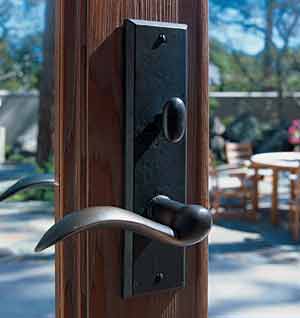Selecting High-End Hardware for Residential, Commercial, and Hospitality Locations
Code Considerations
The American Society for Testing and Materials (ASTM) has a grading scheme for security ratings for doors and hardware (on a scale of 10 to 40) utilizing impact tests. These are becoming more prevalent in areas subject to hurricanes and high winds. Doors need to be engineered correctly to withstand most of these tests. The lock mechanism helps, but it cannot compensate for an inherent weakness in the door itself.
Some national codes, including ADA, are vague and are open to interpretation. For example, ADA 4.13.9 Door Hardware, governs the performance characteristics of door handles, and states "…handles, pulls, latches, locks, and other operating devices on accessible doors shall have a shape that is easy to grasp with one hand and does not require tight grasping, tight pinching, or twisting of the wrist to operate. Lever-operated mechanisms, push-type mechanisms, and U-shaped handles are acceptable designs. When sliding doors are fully open, operating hardware shall be exposed and usable from both sides…."
|
Increasingly, codes are driven by counties and municipalities, acting in response to local conditions. For example, Dade County in Southern Florida is a leader in drafting and mandating stricter hurricane and flood code provisions, many of which have been adopted in Florida, Gulf Coast states, and coastal states along the Atlantic seaboard. Much of Florida's building code provisions are influenced by "weather bands," based on historic studies within the state. Where wind forces are strongest, stricter codes prevail.
Insurance companies are also investing a significant amount of money and resources toward increasing the stringency and rigor of codes. The Texas Department of Insurance is among the most active. Design Pressure (DP) testing is also becoming an industry standard.
Handicapped Accessibility & Ergonomic Compliance
The Americans with Disabilities Act is the national legislation that demands specific handicapped accessibility standards be used in most buildings, whether they be public or private facilities. These requirements have been widely adopted. Individual states may have additional codes which overlay ADA. All of these codes reference door hardware. Therefore, design professionals must be familiar with the codes governing their projects.
For the elderly or disabled, selecting hardware that functions smoothly and with ease is an important consideration. This generally necessitates lever handles and minimum clearances between hardware and adjacent walls. Even in projects where ADA is not a governing factor, levers are typically a better option due to ease of use.
Heavy doors or areas with high winds and inclement weather are also best served by hardware that functions well based on conditions. This generally means that doors should open easily and without the need to apply excessive force. These doors are frequently equipped with automatic door openers.










